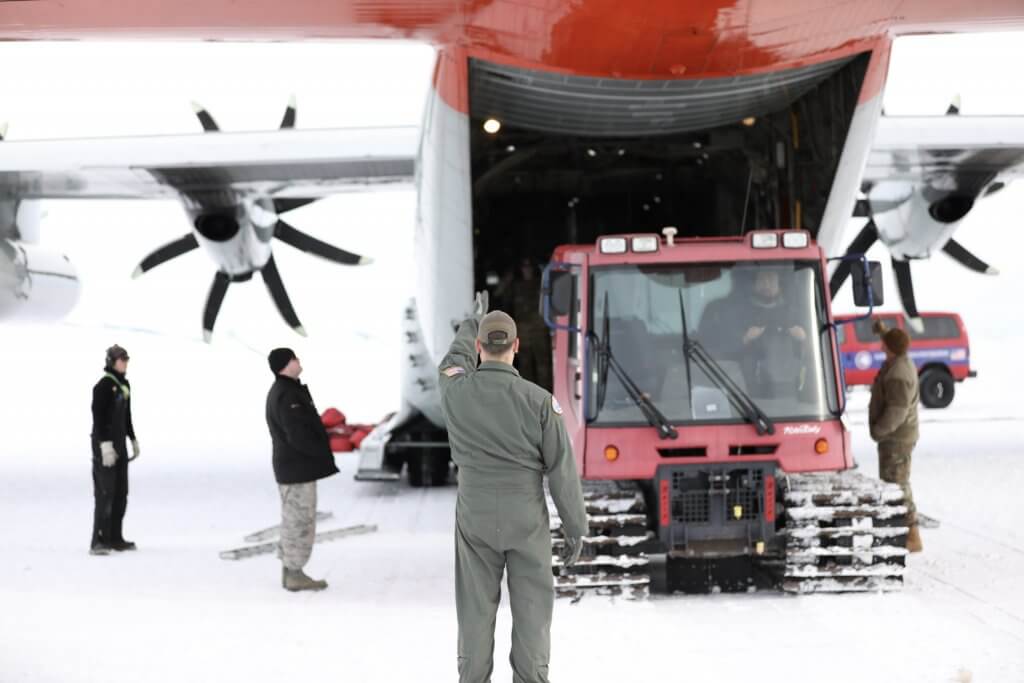More than 180 New York Air National Guard airmen from the 109th Airlift Wing journeyed to Antarctica to support National Science Foundation research despite pandemic challenges.
The team was deployed over the holidays for Operation Deep Freeze, which typically spans from December to February. However, this mobilization required airmen to depart from their home station at Stratton Air National Guard Base two months earlier to accommodate a required quarantine period and COVID-19 screenings on an extended layover in New Zealand.
From there, the aircrews flew three of their special ski-equipped LC-130 Hercules cargo aircraft, or “ski birds,” to McMurdo Station on Antarctica’s Ross Peninsula. The NY ANG owns 10 of the world’s only LC-130 aircraft and deploys them annually to provide logistic support for National Science Foundation personnel and supplies throughout various science stations and snow runways on the southern continent.
Sara Eckert, a spokesperson for the NSF, said the LC-130’s range and unique ski landing gear are critical to providing an intercontinental air link between New Zealand and McMurdo during warmer periods when wheeled aircraft lose the ability to operate.
“The 109th AW’s LC-130 provides the United States unequaled access to the deep field, allowing for large scientific camps at extended range from supply hubs,” Eckert said. “This deep field support allows for continentwide exploration and acts as a logistics multiplier, extending the reach of smaller, more nimble aircraft at these locations. The LC-130 also provides the main airbridge to South Pole Station, located 730 nautical miles from McMurdo Station.”
Tech. Sgt. Gabriel Enders, 109th AW flight engineer, has deployed for Operation Deep Freeze nine times. This year, he stayed behind with many typical mobilizers, as the personnel changeover that would usually occur about a third of the way through the deployment was eliminated to mitigate COVID-19 exposure risks.
“COVID has really impacted the mission, but we’re still accomplishing the mission,” Enders said. “We’re proving we can still operate even under the conditions of a worldwide emergency.”
Working the mission
The team is issued cold-weather gear to endure the 10 F to 20 F degree temperatures of summertime Antarctica. Although, Enders said, the weather doesn’t compare to far lower wind chills during New York winters. Even so, the airmen are required to attend BLAST (Barren Land Arctic Survival Training), where aircrew flight equipment personnel work with Arctic SERE instructors from Alaska to teach survival skills specific to the polar desert.
And, while a three-month deployment may seem cush, Enders said without Wi-Fi and cell service, wasting downtime on social media or video games isn’t an option. Family members understand the challenges their significant others might face when calling home on landline phones and the difference in time zones.
Nevertheless, he also said the camaraderie built among team members during the deployment is worth the consequential digital detox.
Once the mission was complete, Enders traveled to New Zealand, then took the week-long trip to return with the aircraft so his teammates could catch a quicker, more relaxing commercial flight to be home by mid-January.
He, along with the other aircrew, will “puddle jump” to refuel the aircraft about every eight hours on their way back to New York to account for flying at lower altitudes with an excess of heavy cargo. But, Enders said he’s happy to do it, realizing he’s living an experience others might only dream about while contributing to the NSF’s larger federal mission.
“I enjoy the mission just because it’s so unique,” he said. “The places we get to see are places that only 1% of the world’s population will ever get to. It’s very unique, rewarding and a lot of fun to be part of it.”

